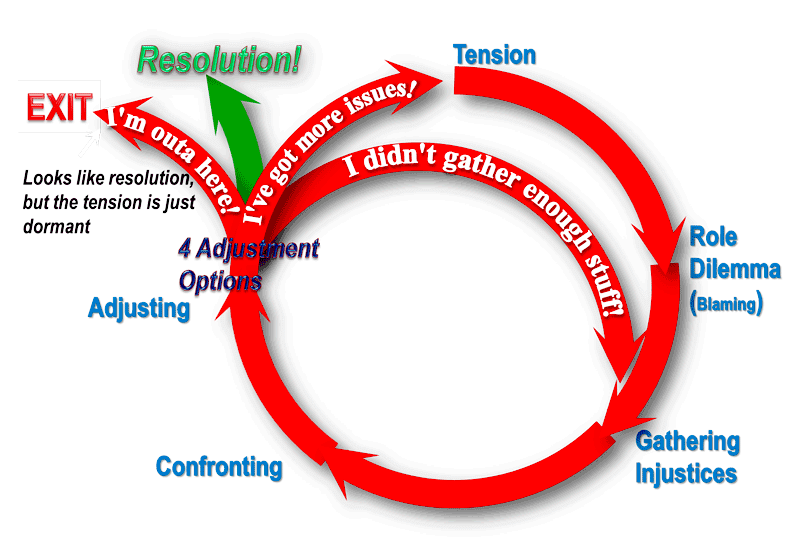Understanding conflict, especially internal conflict, is critical because it isn't necessarily negative; it can be a catalyst for change and a tool for personal growth. Let's look at the foundational elements of conflict; the four types of conflict, the cycle of conflict, and the five conflict styles we develop and use.

Four Types of Conflict
Understanding Internal Conflict
Internal conflict, also known as intrapersonal conflict, arises within us. It's a struggle between our desires, values, or beliefs, leading to tension and often a role dilemma. We may blame ourselves or others for the conflict, gathering injustices to use as ammunition in our internal war.
Where do wars and fights come from among you? Do they not come from your desires for pleasure that war in your members? - James 4:1
When you notice stress or tension in your life, it is easy to think external factors are the source. It is better to look inside and determine what values or beliefs you are ignoring. What you value shows up in where you spend your time and money, so it is natural that you would incur some tension when your values are violated.
Unfortunately, looking inside is not easy for most people because that is an admission that we may be doing something wrong. Guess what, that is why God gave us a conscience and wrote the His Law on our hearts.
When you harden your heart to what God says is right or wrong, you will feel less tension, but you will eventually experience more pain and sorrow. Why? Because God created life, and His ways are THE ways that life works best!
Interpersonal Conflict
Interpersonal conflict occurs between two or more individuals. It can stem from differences in opinions, values, or interests. Like internal conflict, it can lead to tension and disagreements, but the big difference is it now involves you and someone else. As stated earlier, it is an opportunity for growth and understanding when handled constructively.
This is often the second level of conflict, meaning it may start as an internal conflict and become an interpersonal conflict when you do not recognize the tension is coming from violating your values rather than trying to blame it on them.
Intragroup and Intergroup Conflict
Finally, intragroup conflict happens within one group, while intergroup conflict occurs between two or more groups. These conflicts can arise from differences in goals, methods, or even competition for resources. They can lead to tension and discord but can also foster innovation and progress when managed effectively.
Please consider that group conflict arises from individuals. So, again, internal conflict often blossoms into interpersonal, intragroup, and intergroup conflict.
Cycle of Conflict
The Conflict Cycle is constantly waiting for us because of the PROBLEM in relationships - the Flashing ME! You can get more details about the Conflict Cycle here, but the basics are shown in the following graphic.

The Cycle's Elements
It all starts with something, probably some internal conflict, yours or theirs, that creates Tension between you and them (interpersonal conflict). Many times the tension is linked to other unresolved tensions.
Tension leads to a Role Dilemma or blaming the other person for the tension and the problem. Then both of you start Gathering Injustices to use as ammunition for the inevitable showdown. You enter the Confronting phase of the conflict cycle because it's about winning, not resolution. Then you arrive at the critical Adjusting phase, which has at least four options.
- The injustices gathered aren't good enough, so you resurrect old unresolved complaints - "I've got more issues!".
- There is a break in the confrontation, so it is time to "gather more stuff."
- The "I'm out of here!" option can be confusing because it may look like a resolution to some - "agreeing to disagree." The fighting may even stop - at least for a while. But that option only allows the tension to become dormant - no resolution exists.
- RESOLUTION!
Most important, the only escape from the Conflict Cycle is option number 4 - Resolution! That means you pull the power plug to the tension, allowing the past to be OVER.
The Path to Resolution
The only escape from the conflict cycle is resolution. Resolution means pulling the power plug on the tension, allowing the past to be over. Forgiveness and confession are the path to resolution. Forgiveness is the only remedy to overcome the past and the pain someone creates in our lives.
Be kind to one another, tenderhearted, forgiving one another, as God in Christ forgave you. - Ephesians 4:32
Confession is the only path to resolution when you have harmed someone. Here are six guidelines to use when confessing.
Five Conflict Styles
Kenneth W. Thomas and Ralph H. Kilmann researched and identified five common conflict styles or ways you handle conflict. They developed the Thomas – Kilmann Conflict Mode Instrument (TKI) that shows how much of each of the five styles you tend to use. Listen to this podcast, and you can get more information here.
Please keep this in mind – all five styles are helpful and appropriate. You probably will not use these styles in your internal conflict, but when it blossoms beyond yourself, these are the styles you overuse or underuse.
And please do not focus on using just one style, thinking it is better than the rest. That is what gets you in trouble. Each person tends to overuse and underuse styles. It is much better to use a style when the situation needs it. After reading about the styles, determine which ones you use the most and which least.
Compete
When competing, you exclusively pursue your concerns. Competing might mean standing up for your rights, defending a position you believe is correct, or simply trying to win. Always use competing when standing for your values.
Accommodate
When you are accommodating, you ignore your worries to satisfy the other person. There is an element of self-sacrifice in this mode. Accommodating might take the form of selfless generosity or charity, obeying another person’s order when not preferring it, or yielding to another’s point of view. It can also give in just because you fear providing your thoughts. It is best when seeing the other person’s points are better than yours.
Compromise
When compromising, the objective is finding a quick, mutually acceptable solution that partially satisfies you and the other person. Compromising falls on a middle ground between competing and accommodating, giving up on competing and accommodating by mixing them. And it addresses an issue more directly than avoiding it but does not explore it in depth as collaborating. Compromise might mean splitting the difference, exchanging concessions, or seeking a quick middle-ground position.
Avoid
When avoiding, you do not immediately pursue your concerns or those of the other person. You do not address the conflict. It might be diplomatically sidestepping an issue, postponing it until a better time, or simply withdrawing from a threatening situation. The most critical element in using this style properly is this thought – now is not the time, but we will discuss it soon. In other words, it could be said, “Not never, but definitely not now.”
Collaborate
When you work together, you work with the other person to find a solution that meets both concerns. It involves digging into an issue and spending time and energy to find a solution that fits both of you. Collaborating between two persons might take the form of exploring a disagreement to learn from each other’s insights, resolving some condition that would otherwise have them competing for resources, or confronting and trying to find a creative solution to an interpersonal problem. The downside of collaborating is the extensive amount of time and energy required.
Conclusion
Understanding and resolving internal conflict, interpersonal conflict, intragroup conflict, or intergroup conflict is crucial to personal growth. By recognizing the types of conflict, the cycle of conflict, and the styles of conflict, we can better navigate our struggles and move toward resolution.
Remember, conflict is not inherently negative or harmful. When used correctly, it is a tool that can lead to growth, understanding, and, ultimately, peace.
Videos you may like
Podcasts you may like
